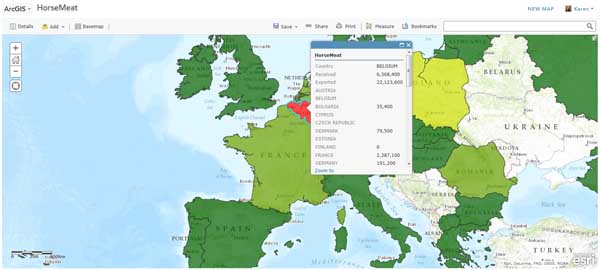Location analytics gives global manufacturers new visibility into each stop on the way to the shopper
When pork was found in Ikea’s moose lasagna in Europe, as you can imagine, this had significant ramifications with both the Jewish and Islamic communities.
Cadbury suffered a major brand debacle because swine DNA was found in candy bars for sale in Malaysia—a predominantly Muslim nation.
Then of course, the yuck factor, otherwise known as food fraud: horsemeat in beef products throughout Europe, the fact that most of the olive oil, honey, and maple syrup is not what it says it is.
What if we could see every touch point and monitor all the processes that are necessary at this vast global scale to get that chicken nugget safely from a meat packing plant to your toddler’s table?

It shouldn’t. Because successful companies are doing this now.
Operating Blind Leads to Breakdown
Nearly half of global manufacturers say they don’t have any visibility past their tier one suppliers, and only nine percent of the 335 respondents of the study said they had complete visibility.

First is the safety issue: last year the news reported that fecal matter has been found in more than 80% of ground turkey in 21 states across the United States. Salmonella outbreaks are a continuing problem; this year alone the US Centers for Disease Control and Prevention have reported outbreaks on nut butters, chia powder, chicken, and cheese. The latest debacle is the expired meat being supplied in McDonald’s, Papa John’s, Burger King, Starbucks, KFC, and Pizza Huts across Asia.
Second is the cultural and religious standpoint: In Islam, only halal foods are allowed; in Judaism, food must be kosher. Both do not allow the consumption of pork. And Hinduism cannot allow the consumption of beef.
Location Analytics to the Rescue
Looking at the entire supply chain—whether it’s the pig that winds up as a hotdog at a local food joint, or the cacao beans that are nicely wrapped in gold foil at the supermarket, and including all the various forms they take in between from the beginning to the end—makes sense on a map. Because it all happens somewhere.

Supply chains are being optimized and reformatted as new innovations occur every day. Introducing GIS and location analytics, technologies that are being used by millions of organizations throughout the world for the past three decades, should be one of them.
It’s time for our supply chain to catch up to the 21st century. Learn more.
insider
